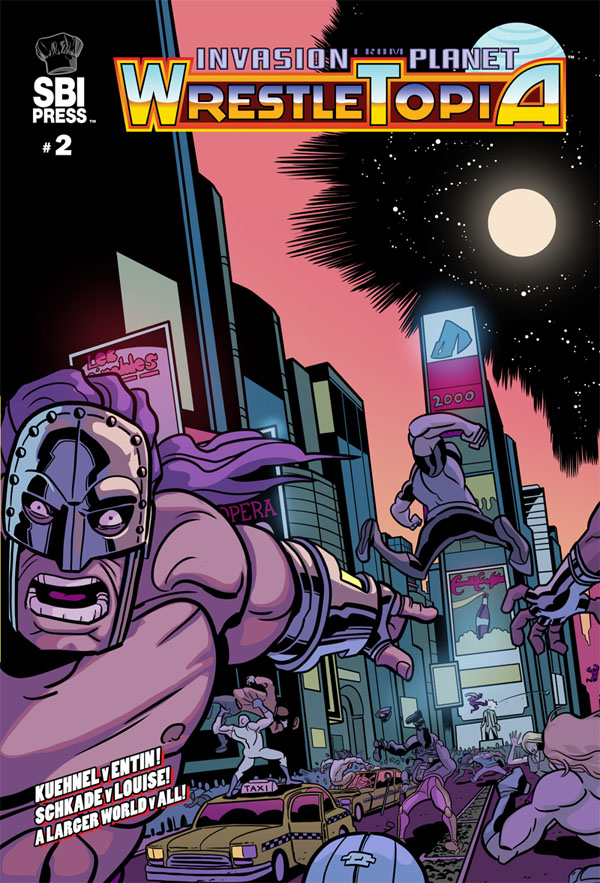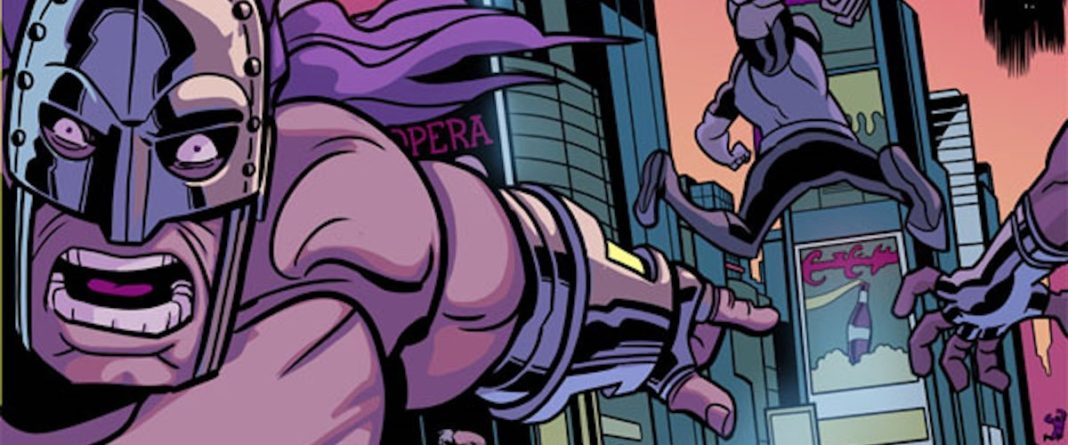
Wrestling can be a deceptively complex medium to translate into comics. As a creator, you have to be aware of the culture behind it and know of its legends and its giants just as much as its rules and its idioms. In other words, creating a wrestling comic is a true labor of love. It requires an understanding of sports entertainment and its unique approach to spectacle to fully appreciate its rich storytelling possibilities. Invasion from Planet Wrestletopia ticks all those boxes. And then some.
I got to the review the series’ first issue and by the end of it I had become a Wrestletopian maniac (you can find the review here). The book proves that sci-fi and wrestling make sense together, especially when the wrestling part functions as its leading voice. It allows for the development of some deeply conflicted characters that struggle with the personal costs of becoming a legend of wrestling, which is a title that already has a cosmic feel to it.
That Invasion from Planet Wrestletopia achieves this with its characters should come as no surprise to those who know of Kuehnel and Entin’s previous work, specifically in the world of video games. The writers collaborated, along with Gerard Barnaud, on the indie hit Valiant Hearts: The Great War (2014). The game follows a group of characters trying to survive the First World War in a series of puzzle-based scenarios structured around a very emotional character-driven narrative. There’s some Valiant Hearts present in Planet Wrestletopia. As the comic shows, wrestling is as much a story of violence as it is about heart, which isn’t too distant to what war stories are. If you haven’t played Valiant Hearts yet, I highly recommend it.
I had a chance to sit down and talk wrestling and comics with Kuehnel and Entin and on what type of intergalactic championship matches we can expect in the coming issues. The interview follows below.
Ricardo Serrano: The first question is one of the most obvious ones just because when I read your book I remember thinking “or course wrestling and sci-fi fit together. Why wouldn’t they?” I also remember thinking that it takes a genuine wrestling mind to make this type of story work. How did you arrive at that pairing of wrestling and sci-fi?
Ed Kuehnel: I think it started with the idea of what if there was this planet on which wrestling was very real and they invaded Earth. And what if our only hope was this washed up, alcoholic professional wrestler slumming it in casinos. What if the entire fate of the world was in his hands. There had to be a broadcast that would go out into space and reach that wrestling planet. There would be a promo with our wrestler proclaiming himself the champion of the galaxy, which would piss off the champion of Wrestletopia and spark an invasion. That was the elevator pitch. We came up with the idea some 10 years ago and then we just decided to put it out in the comic book world.
Matt Entin: The decisive image for me, and this was an Ed invention, was a steel cage around Earth. That’s what really sold me that this concept had merit.

Kuehnel: Well, the actual history of professional wrestling is kind of murky. It comes from the circus as far as people can tell. It’s hard to pin down but it gave us a lot of room to maneuver. It got me thinking of Killer Clowns from Outer Space, where you’re thinking maybe this is how we got on to clowns, they came from space. It’s a bit like Wrestletopia, where maybe we got into this wrestling thing because…aliens.
Entin: Or vice versa!
Serrano: So how did you guys get into wrestling? Did come from an early age or was it something you came into later and then said “why didn’t we get into this sooner?”
Entin: So there’s some seven years between Ed and I so we grew up in different wrestling eras. I was a kid of the eighties, where Hulk Hogan was as big as Coca-Cola and the WWF (before it was the WWE) was completely dominant. I was originally exposed to it through the Hulk Hogan Rock n’ Wrestling cartoon. I watched whatever was available, Saturday Night main events and prime time network TV wrestling events. High school and college for me was during the Attitude era, and that’s what sealed the deal for me. It made me a life-long fan.
Kuehnel: I discovered wrestling in the seventies. I was born and raised in Portland and we had this NWA territory, Pacific Northwest Wrestling and we watched that every Saturday. As a kid I was one hundred percent convinced it was real and was fascinated by it.
And then, not much later, we got this primitive cable TV that had Superstation WTBS from Atlanta, which had Georgia Championship Wrestling. That was the epicenter of the NWA wrestling scene. It had Ric Flair, Dusty Rhodes, and all these other guys. It was three hours every Saturday. Even ESPN was showing AWA as part of its regular programing when it started out. I was obsessed with it. WWF came later and I spent a lot of time convinced it was real. Dove into magazines and everything. It made me happy and I have a lot of nostalgia for it. I did drift away later on and don’t actively watch wrestling today, but all that wrestling history is still there in my head and it’s a big part of me.

Entin: I think we naturally gravitated towards the 80s because it was an era we were both familiar with and also just the colorfulness of the characters definitely lends itself quite well to the comic book medium. I mean, our characters are drawn more broadly and over the top, we thought there was a compelling contrast between who they play on TV and who they are in their real lives. The remainder of the series takes place in 1999, which is firmly the Attitude era. Rory, our main character, is presented as a man ahead of his time. He played the heel in a time where heels weren’t promoted as widely as they would be in the 90s, in full Attitude era. He kind of missed his shot. He was born ten years too late. He’s a jilted relic of a different era who was a pioneer but missed his shot by a decade.
Kuehnel: It’s also a fun couple of decades to work with. In the 90s you get to play with anti-heroes being the faces of wrestling. In this context, Rory has to figure out how to save the planet, how to do this heel to face turn (going from bad guy to good guy) in real life. The timing works out really well.
Serrano: We’ve seen some new wrestling comics coming up in the past few years and I’ve noticed that they’ve had to make a decision in terms of how to approach the actual wrestling matches in the comics page. BOOM’s WWE series, for instance, plays with narration and action in its fight sequences. Then again, some manga wrestling books go for more of a combination, with an emphasis on action rather than narration. How did you approach the actual matches in your story?
Kuehnel: One thing I’ll say, and this came organically, when people are fighting, they generally don’t talk. Monologuing while punching definitely has its place in comics, for sure. But for me it’s more of an in-the-moment event where you let the action do more of the talking. In Wrestletopia we have that matches can happen anywhere. In one issue we have a fight break out in a waterpark, which is super fun and allows us to create fight sequences that are interesting and fresh.
Matt: The wrestling scenes also grow organically out of the story. In WWE comics everything is build up to a match, whereas we were looking for matches that broke out spontaneously. In our setting, that has definitely given us an advantage. It’s easier to weave these action scenes in our comic. If we were writing a WWE comic then our approach would be different.
Serrano: As I said before, it takes a wrestling mind to put something like this together. If you’re a fan, then reading Invasion from Planet Wrestletopia will also be an exercise in identifying those wrestlers and personalities who served as inspiration for the comic’s own characters. I remember wrestlers like Jake the Snake, Razor Ramon, and even Mean Gene Okerlund in the promo scenes were being echoed in the story. What wrestlers did you have in mind when creating your characters?
Kuehnel: We did a lot of research and read a lot of behind the scenes books about the industry and kayfabe magazines that furthered the illusion it was all real. So our characters became an amalgam of personalities that then take a life of their own. Still, I’ve heard some people say they read Rory in Macho Man Randy Savage’s voice, some read it in Hulk Hogan’s voice. We’ve heard Jake the Snake too. Who I think nobody’s mentioned before is Superstar Billy Graham.
Entin: Rory’s personal life was very much modeled on Jake the Snake’s, but his in-ring persona was inspired by Superstar Billy Graham. Billy Graham was very much of ahead of time as well. I mean, Hogan’s been accused of plagiarizing his persona. You know, 24-inch pythons was Superstar Billy Graham and the schtick that Hulk Hogan took to the next level and sold to the masses was really pioneered by him. Then again, Superstar will tell you that he borrowed his stuff from Muhammed Ali, and Ali could say he borrowed stuff from Gorgeous George. It’s a kind of lineage.

Entin: The big difference is that with video games we’re often working for somebody. Often we’re working with intellectual properties with little leeway as to playing around with the IP. Wrestletopia was the first time we had complete creative freedom and complete control of our creative vision.
Video game writing is very different due to the interactive element. It’s honestly a relief to not have to account for player choice, but I would say that once you get down to writing 23 comic book pages, you have a lot less space than you think. Writing for video games, it’s all about brevity. You want to say everything you have to say in, usually, 30 to 45 seconds if you’re writing cutscenes. The biggest lesson I got from video games is brevity and it helped when we were trying to cram so much story in 23 pages.
Kuehnel: It’s so much nicer to work on a linear story and not worry about a million different scenarios that might happen due to branching narratives and branching dialogues. But being brief and letting the visuals help carry the story was something I got from video games. Video game writing was great training for a lot of the comic production stuff, though. Managing all the moving parts was an interesting process because of it. Our team, artist Dan Schkade, colors by Marissa Louise, letters by Dave Lanphear, Fred Chao designed the first three issues, they all made that process work so well. I think our experience in video game production helped us keep the project moving while allowing everyone to have the space to do their best with the story.
Serrano: Thanks, guys!
Kuehnel: Good talking to you!
Entin: Thanks!
Invasion from Planet Wrestletopia is released every two weeks on ComiXology via SBI Press. You can follow the creators on Twitter @EdKuehnel and @themattentin, or keep up with the publisher @SBI_Press.








